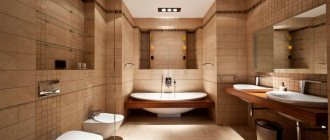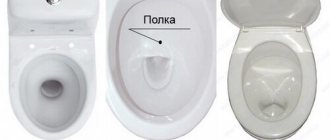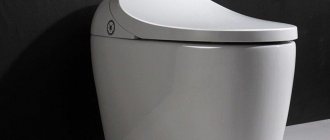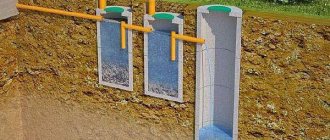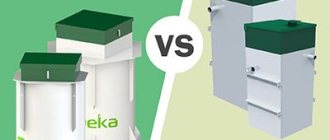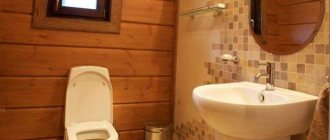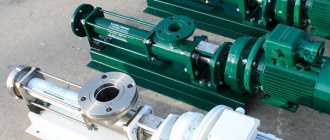You complete the renovation of your toilet room and begin choosing plumbing fixtures. The market for plumbing products offers a huge variety - from classic models to exquisite designer shapes. However, it is necessary to clarify that there are two main types of modern toilets - the classic floor-standing toilet with a cistern and the “air” model, which became a competitor to the conventional “grounded toilet”, invented by marketers in the 80s - the installation toilet.
- 2 Main characteristics of classic toilets
- 3 Differences between installations and conventional toilets
- 4 Pros and cons of toilets and installations
- 5 Is an installation always more expensive than a conventional toilet?
- 6 Let's summarize
Main characteristics of the toilet installation
An installation is a structure consisting of a metal frame with special mechanisms, designed to secure plumbing items - sinks, toilets, bidets. The appliances are attached to the wall, which creates a feeling of airiness in the space and allows you to place the plumbing fixtures at various points in the space.
Installations
save space and hide drains: all pipes and communications remain out of sight and are placed in the wall, which brings additional aesthetics and hygiene to everyday life.
The installation greatly expands the space of the bathroom or toilet, allowing you to experiment with the arrangement of figures in space and establish harmony according to your taste.
All installations have the same fastening standards, regardless of which company is the manufacturer. Thanks to this fact, you don’t have to worry about whether the component will fit into your existing installations - all sanitary ware products are standard.
If you have an apartment with a free design, and you need to place plumbing fixtures on plasterboard walls, of course, in this case, installations win, since sinks are often too heavy for these walls. To solve this problem, there are installations whose frames are attached to the floor and wall equally, which does not create a load on thin walls. Thus, the installations fulfill a practical and aesthetic task at the same time.
Installation breakdowns are very rare and mainly relate to the flush button, which is located on the screen in front of the toilet. Also, all installations provide for double flushing, and whether it will be launched is up to you. The installation system is equipped with silent flush technology, which allows you to adjust the sound when flushing water.
Installations allow you to safely experiment with the space and design of your bathroom and are great space savers; they are considered one of the most durable and reliable technologies for the home.
They will make the space of the toilet room modern and relevant in solution.
How to choose correctly. Adviсe
- A circular flush maintains cleanliness much better.
- The tank flush button can be connected to the fittings using pneumatics or mechanical devices (cable/lever). The latter are considered more reliable.
- To save water, you can install a system to stop the drain when you press the button again. Also pay attention to the two-button flush, when only half of the tank or its entire volume is used.
- Plumbing products from Germany and Italy have proven themselves best. Bulgaria and the Czech Republic produce high-quality products in the mid-price category.
Electronic shower toilet - Despite the external miniature of the device, before purchasing it is necessary to take measurements and compare them with the dimensions of the bathroom.
- If you are thinking about purchasing an additional bidet, please note that some models of wall-hung toilets already have this function.
- Before purchasing, be sure to read the quality certificates, technical documentation, and make sure there is a warranty. This way you will protect yourself from frequent repairs, and the purchased plumbing equipment will not fail prematurely.
Main characteristics of classic toilets
The classic type of toilet is a structure that is attached to the floor and behind which is a flush cistern. The main advantage of a classic-shaped toilet is that it can be mounted anywhere in the toilet room.
A classic toilet takes up approximately 50 cm more than any wall-hung structure, the cistern of which is built into the wall. Now there is a huge variety of design and style solutions for classic toilets, but in any case, the cistern is located outside - monolithic with the toilet, mounted on the wall, located nearby.
Reviews
“After the renovation, our bathroom was transformed. The main role was played by the wall-hung toilet. I admit that I decided on this new design after much thought. But now I can say that it is very convenient. The new toilet takes up much less space, thereby visually enlarging the toilet room. You can wash the floor under it without any problems, because it has no legs. In addition, it looks very aesthetically pleasing. The only thing that can stop you from choosing is the high price.”
Olga, Novgorod region
“I installed this version of the toilet at home quite a long time ago, made in Germany by Grohe. Back then it was still a novelty. And during all this time there was no serious damage, and the craftsmen did everything conscientiously during the repair and installation of the wall-hung toilet. It’s convenient to clean around it, under it, nothing gets in the way and it’s easy to get to from all sides.”
Dmitry, Kaliningrad
“I recently purchased a wall-hung toilet with installation from Cersanit Delfi Leon and would like to share my impressions. Compact, convenient, with reduced noise when draining and collecting water (which is important, given the poor sound insulation in the apartment). The absence of a tank visually expanded the bathroom space. And in general it looks beautiful! I don’t regret buying and installing it at all.”
Andrey, Moscow region
Differences between installations and conventional toilets
- Unlike a classic toilet, the installation can be mounted anywhere. Withstands weight up to 400 kg, so fears about the structure breaking or breaking are unfounded.
- Installation toilets do not take up much space and are easy to clean - there are no legs near which bacteria and dust can accumulate, all pipes and structures are hidden in the wall.
- The structure is mounted on a rigid steel frame and is equipped with retractable rods, which allows the installation to be adjusted in height. The steel frame is equipped with studs and threaded sockets into which fastening bolts are screwed.
- The installation tank is traditionally made not wide in size and is mounted in a recess made of styrofoam, which prevents water condensation from appearing on it. At the front of the tank there is a cutout for the water drain button, through the drain panel. Through it, diagnostics and repair of water drainage in the tank are carried out.
- Using a hole in the side of the tank, the system is connected to the water supply; usually for this task there are several holes on the tank, which can be selected depending on the location of the pipe.
- In the installation tank itself there is a valve for shutting off the water, a system for regulating the drainage and protecting against too much water, which allows you to regulate the mechanisms for entering and exiting water into the tank. Therefore, you can regulate the flow of flushing water and stop it if necessary. This quality is also quite useful.
Installation instructions for the mounted model
The main installation guide is always the instructions that come with both the toilet and the frame. Usually it looks like several diagrams or drawings indicating dimensions and order of actions.
If you are not ready to decipher the schematic instructions yourself, it is better to turn to experienced plumbers, since accuracy and qualifications are very important when installing the frame structure, pipes and bowl.
Stage #1 – preparatory work
Preparation includes the purchase of the necessary plumbing equipment and additional installation parts.
Flax is useful for sealing, and silicone with a gun is used for processing joints. Also, plumbers often use flax as a sealant, but you need to train it to wind it correctly
You also need to get the tool:
- hammer drill + drill 10 mm;
- grinder;
- a set of keys, including gas and adjustable;
- screwdriver;
- hammer;
- marking tool - tape measure, level, marker;
- soldering iron or press pliers - for welding polypropylene pipelines or crimping metal-plastic pipes.
You will learn which is better to choose: polypropylene or metal-plastic pipes from our recommended article.
When everything is prepared, turn off the water and assemble the installation. Before installing the frame, some mounting elements are installed on it - brackets, adapters, pipes. We attach a fitting to the tank hose.
Stage #2 – installation installation
Before installing the installation for hanging plumbing, we prepare the place - we install sewer and water pipes, securely fasten them to the wall with clamps. Throughout the entire installation process, we remember that the structure will be covered with plasterboard, so we carry out all work responsibly.
There is a sticker on the frame with markings indicating the maximum installation height. We try to respect this value; we calculate from the finished floor - not from concrete, but from ceramic tiles. If it has not yet been laid, we calculate the difference.
We monitor the location of the holes for attaching the bowl. As a result, it should be at a height of about 40 cm; if higher, it will be difficult to use the toilet; lower, it will be inconvenient.
We install the frame in place, adjust the height by adjusting the legs - loosen and then tighten the adjusting bolts.
We insert the adapter for the sewer pipe - a large black plastic corner that comes with the frame. Subsequently, you need to insert a pipe from the toilet into it
During the “trying on” we mark the attachment points, then remove the frame and drill holes in the floor with a 10 mm drill.
They are also on the wall (main), but there are different fastenings - for studs that hold the frame at a certain distance from the wall.
We hammer plastic plugs into the holes, install the installation in place, and tighten the bolts. If the ends of the studs protrude outward, saw off the excess with a grinder. Along the way, we use a level and level the position of the horizontal parts by adjusting the legs
We tighten the nuts, tighten them, and connect the tank tap. In place of the button installation we install a foam template, which is removed only after the partition is erected.
We specify the distance between the mounting studs for the toilet (there are 2 options), screw them into the required holes, and put on the protective elements.
Stage #3 – fixing the bowl
If the installation is installed correctly, installing the bowl will not take much time. Usually, between these two stages, a partition or box is installed to mask the installation.
We measure the distance from the pipe outlet to the toilet flares, which are located in the inner part of the bowl facing the wall. We put pipes on them and push them all the way.
Since the studs and connections were prepared at the installation stage, all that remains is to lubricate all elements of the toilet with a special lubricant and install it on the fasteners. Lastly, fix the seat
First we put on the washers, then just tighten the nuts.
Stage #4 – attaching the flush button
We remove the foam template and attach a plastic installation frame in its place. We use the screws that are included in the kit and a screwdriver or screwdriver. Then we screw in the threaded rods that will be controlled by the button, adjust their position and fix them.
The elements from the installation kit fit together perfectly, so you don’t need to put in much effort, just follow the steps specified in the instructions
The final touch is the installation of a decorative strip with a button. Apply it to the rods and press until it clicks. Let's check how the mechanism works.
After completion of the work, we complete finishing activities. Do not forget to equip a plumbing hatch for access to internal communications, otherwise at the first accident you will have to dismantle the partition.
Pros and cons of toilets and installations
Of course, the installation is a fairly hygienic design, all pipes are removed and hidden, the absence of a leg in the structure does not interfere with thorough cleaning and the heated floor system. the toilet bowl itself is accessible and open , which is smaller in size than the classic bowl.
An indisputable fact is that both visually and practically it greatly expands the space of the toilet room. Let's look at the disadvantages of installations:
- Since all communications and pipes are hidden, the rule of free access to communications is violated.
- If suddenly a breakdown occurs in the tank, then in this case you will have to call a plumber from the service department, although breakdowns with the tank in the installation occur infrequently, this creates certain additional tasks for the service and costs for the owner.
- If replacing a classic toilet is a spot-on procedure, then replacing the installation may even entail the need for a new renovation of the toilet room.
- The block installation must be mounted only on a strong platform and cannot be placed on partition walls, since the steel frame must be permanently attached. A classic toilet can also be placed near partition walls; it has wider placement options in the bathroom and is less demanding on mounting power.
Top 7 best cast iron bathtubs
Cast iron is a true classic of plumbing. Nowadays, only bathtubs are made from it, but in the past you could find sinks and toilets made from this material. They are gradually abandoning it, considering it too heavy and conservative, but such products are still popular, as they have serious advantages over others.
17.03.2020
Is an installation always more expensive than a conventional toilet?
When choosing a particular form of toilet, pay attention to everything - color, material, shape, sit on it. If you want to use this product in everyday life, it should be, first of all, practical and aesthetic for you. The fleeting euphoria of a beautiful shape when purchasing can result in inconvenience in use, so check your preferences carefully.
When choosing a toilet, much depends on the design solution of a particular product—both classic toilets and installations in this case have a wide variety. The material from which the plumbing item is made is of great importance - plastic, cast iron, steel, glass, earthenware, porcelain. Porcelain is considered the most expensive, beautiful and durable material. It is easy to clean and not as hygroscopic as earthenware. The simplest toilets in terms of shape and materials have the lowest prices . The design solution of a product always raises the price, but most often it relates only to the appearance and does not affect the basic functions of the toilet.
It is worth noting that the toilet itself and the installation system have separate prices and are almost equal to each other, that is, it is
twice as expensive as a similar set of a classic toilet.
But - as already mentioned - all parts of the installation structure can be purchased separately and, thanks to production standards, they will always fit together. Classic monolithic floor-standing toilets have a fairly high price, while those externally stylized as antique with modern functions are the most expensive.
It’s worth considering when purchasing that installers charge 10–15 percent of the cost of the toilet for installation. If you can install a classic standard toilet yourself, then when installing the installation you cannot do without professional service.
Discount in the Inch24 online store for my viewers
I agreed on a discount with Inch (an online plumbing store). To get a discount, follow this link https://bit.ly/d24-dobrotehnik, place an order and enter the code word: dobrotehnik The promotional code is valid throughout 2017. The minimum guaranteed discount is 3% (depending on the order amount, the larger the order amount, the greater the discount the manager will give). The discount applies to any product. The offer is primarily relevant to Muscovites and residents of the region. But Inch24 delivers orders all over Russia, you just have to check the delivery conditions separately with the managers.
Let's sum it up
- A priori, installing the simplest installation process is in any case twice as expensive as a classic toilet with similar characteristics. Plus - if you can install the toilet yourself, then most likely you will have to invite a specialist for installation.
- In any case, there must be a very strong platform for mounting the installation - either the floor or the wall.
- The installation of the installation must be taken into account when designing the toilet - it is necessary to take into account the nuances of access to the wall in case of repair.
- If you want to install the installation somewhere in the country far from the service department, get ready for the fact that you will need to be able to understand the system yourself.
In principle, both the installation toilet and the classic forms of this necessary item have a wide variety in terms of style and options - you can choose according to your taste and the amount you plan to allocate for the purchase. In this case, the choice comes from the spatial design of your toilet room and from your personal preferences in the use of certain items in everyday life. This important element of everyday life should also be aesthetic, practical and calm.
Popular manufacturers
Reviews for a high-quality wall-hung toilet with installation will also be positive. Especially if you purchase a model from a well-known manufacturer.
The following brands can be distinguished:
- Laufen (Switzerland), whose products are in the price range of 4-100 thousand rubles;
- Roca (Spain), which produces luxury products worth 2-500 thousand rubles;
- Ifo (Sweden), which has set prices for its products in the range of 3-100 thousand rubles;
- IDEAL STANDARD (USA) with prices of 2-100 thousand rubles. A distinctive feature of the company is the production of products in collections, each of which has its own style;
- Cersanit (Poland), which has affordable prices - 2-10 thousand rubles;
- Jika (Czech Republic), Santek, Keramin, Sanita, Iddis (Russia), operating in the price range of 1.5-11 thousand rubles.
Among direct installations, the leaders are Grohe and Geberit.
The price of hanging plumbing is higher
It is generally accepted that floating analogues are more expensive than toilets on a support. This is often true, but it depends on what you compare. If you contrast an imported installation with a low-cost budget model of a traditional toilet, the latter will be cheaper, but if you compare models in the same segment and from similar manufacturers, the wall-hung option may turn out to be even more affordable.
What will really cost more is the installation of a suspended model. Especially when it comes to renovating secondary housing.
If the installation replaces a floor structure, the sewer wiring will need to be redone.
Top 7 best steel bathtubs
Steel bathtubs are the golden mean between the high price of acrylic products and the difficulties of operating cast iron ones. They are easy to install, have a wide range of sizes and are durable. The main secret is choosing not only a suitable model, but also a manufacturer with a good reputation. We present the top 7 best steel bathtubs - the latest rating of 2021 based on the results of monitoring reviews on the Internet.
09.03.2020
